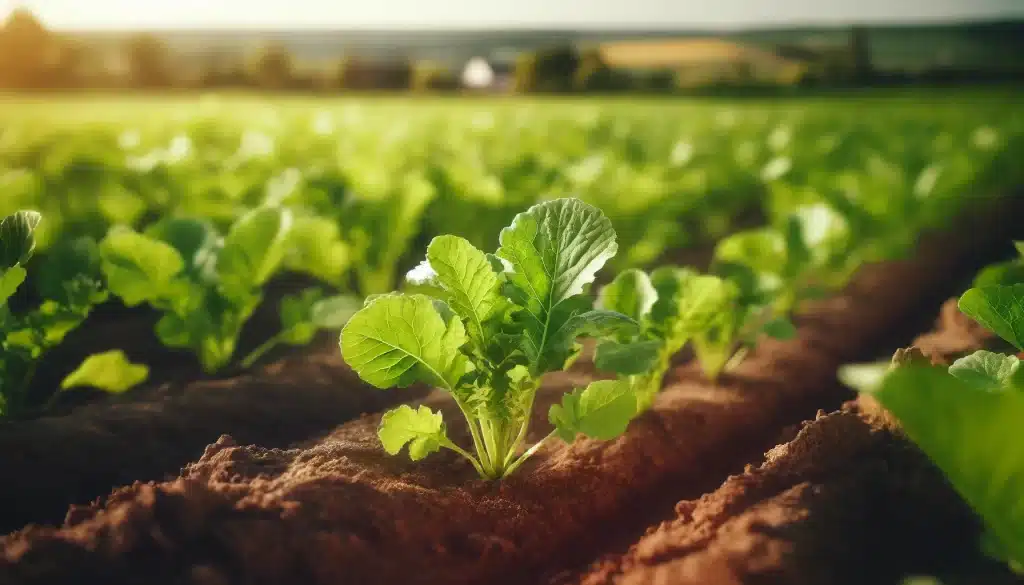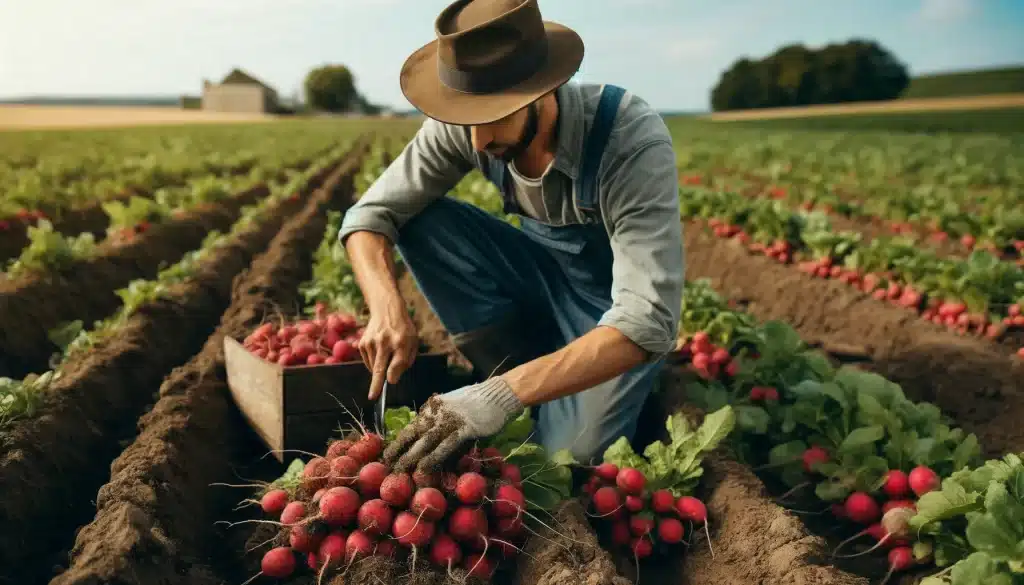Radish is a fast-growing crop that has earned a place in gardens and farms due to its ease of cultivation and nutritional value. To maximize the production and quality of radish roots, it is essential to understand the plant’s phenological stages and apply appropriate agricultural practices at each stage. From sowing and germination to harvest, each phase of radish development requires attention to specific aspects such as soil management, irrigation, fertilization, and pest control. In this detailed analysis, we will explore the phenological stages of radish, providing technical descriptions and recommended practices for each phase, with the aim of helping farmers optimize the yield and quality of their radish crops.

Phenological Stages of Radish with Best Practices
1. Sowing and Germination
Radish sowing is done directly into the soil, preferably well-drained and with good organic content, at a depth of approximately 1-2 cm. Seeds are sown 2-3 cm apart and with rows spaced 10-15 cm apart. Germination occurs quickly, usually in 3-5 days, when soil temperatures are between 10 and 30°C. It is crucial to keep the soil consistently moist but not waterlogged to encourage uniform seedling emergence.
Best Practices:
- Use high-quality seeds and ensure even sowing.
- Prepare the soil adequately, ensuring a loose texture and good drainage.
- Maintain consistent soil moisture during germination.
- Protect young seedlings from pests and diseases with preventive measures.

2. Initial Vegetative Development
In this phase, which lasts approximately 10 to 20 days, radish seedlings develop their first true leaves and begin to establish a more robust root system. Regular irrigation is necessary to ensure continuous growth and avoid water stress. It is important to provide essential nutrients, especially nitrogen (N) and phosphorus (P), to support foliar and root growth. Additionally, weed control is essential to reduce competition for nutrients and water.
Best Practices:
- Apply fertilizers rich in nitrogen and phosphorus.
- Conduct regular irrigations, adjusted to the needs of the seedlings.
- Control weeds through manual weeding or appropriate herbicides.
- Monitor and control pests and diseases preventively.

3. Root Development
During the next 20 to 40 days, radish roots begin to thicken and accumulate nutrients, which is crucial for the development of high-quality roots. Potassium (K) becomes essential in this stage to promote thickening and root quality. It is advisable to apply potassium-rich fertilizers and continue with adequate irrigation, ensuring that the soil does not dry out completely between waterings. Pest and disease control should be rigorous, as growing roots are vulnerable to various pathogens and pests.
Best Practices:
- Apply potassium-rich fertilizers to support root thickening.
- Maintain consistent and adequate irrigation to avoid moisture fluctuations.
- Continuously monitor and control pests and diseases, using biological or chemical methods as necessary.

4. Root Maturation
In this phase, which lasts approximately 40 to 60 days, radish roots reach their optimal size and weight. The plant reduces its vegetative growth and redirects energy towards root thickening. It is crucial to reduce irrigation to avoid excess moisture that could damage mature roots. Pest and disease monitoring should continue, although the need for fertilization decreases in this stage.
Best Practices:
- Reduce irrigation to avoid excess moisture.
- Continue monitoring and controlling pests and diseases.
- Reduce fertilization, focusing on crop maintenance.
5. Harvest
Radish harvesting takes place between 40 and 60 days after sowing, depending on the variety and climatic conditions. The optimal harvest time should be chosen when the roots have reached their ideal size and color. Harvesting is done manually, taking care not to damage the roots. Subsequently, the roots should be cleaned and, if necessary, cured in a dry, ventilated place before storage or processing.
Best Practices:
- Determine the optimal harvest time.
- Manual harvesting, avoiding root damage.
- Clean and cure the roots before storage or processing.

Implementing these best practices at each stage of the radish’s life cycle is essential to maximize yield and quality. Each phase has its own challenges and requirements, and attention to these details can make a significant difference in the success of the harvest.
Phenological Stages of Radish, Estimated Duration in Days of Each Stage, and Nutrient Recommendations per Hectare
| Phenological Stage | Duration (days) | Nutrient Recommendation (kg/ha) |
|---|---|---|
| Sowing and Germination | 3-5 | N: 40-60, P: 20-30, K: 20-30 |
| Initial Vegetative Development | 10-20 | N: 60-80, P: 40-60, K: 30-50 |
| Root Development | 20-40 | N: 40-60, P: 30-40, K: 60-80 |
| Root Maturation | 40-60 | N: 20-30, P: 20-30, K: 40-50 |
| Harvest | 60-70 | N/A |
 AgronoBlog – Agriculture Blog
AgronoBlog – Agriculture Blog 